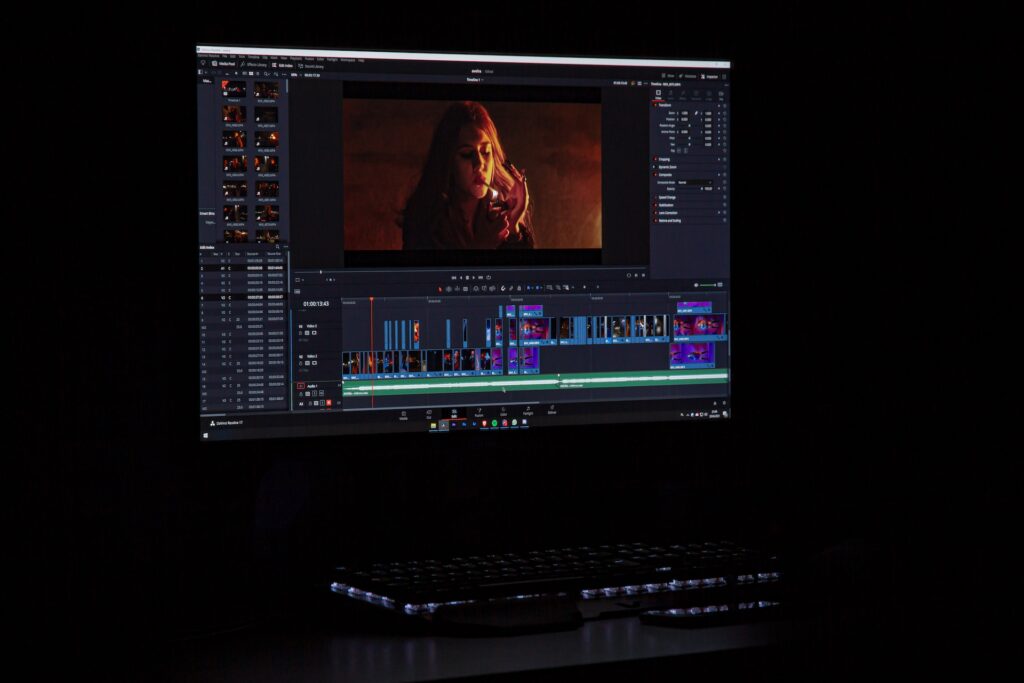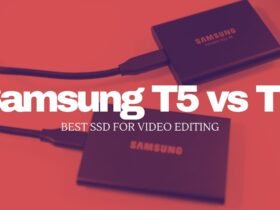Hi, I’m Salik, the author of FilmmakingElements.com. I have been a filmmaker for over 10 years. I am also a certified DaVinci Resolve Trainer and I have used DaVinci Resolve for many of my projects. One of the most common questions that arises is whether to choose AMD or Intel processors for their DaVinci Resolve workstation.
In the world of content creation and video editing, software like DaVinci Resolve has become an indispensable tool for professionals and enthusiasts alike. With its robust feature set and powerful performance, it’s no surprise that users are constantly searching for the best hardware to optimize their experience.
In this article, we will delve into the intricacies of these two CPU giants, examining their strengths, weaknesses, and overall performance in the context of DaVinci Resolve.
By the end, you’ll have a clear understanding of which processor is better suited for your specific needs and be well-equipped to make an informed decision for your next workstation upgrade.

Focusing on the Prosumer Market
It’s essential to note that our comparison will focus on the prosumer market, covering processors ranging from Ryzen 5 to Ryzen 9 (59, 50X) and Intel i5 to Intel i9. We will not delve into the realm of Xeon chips or Threadripper chips, as these are aimed at a completely different league of users with significantly higher price tags and performance capabilities.
For instance, the Ryzen Threadripper Pro 3990WX costs around $6,000 to $7,000, which is equivalent to the cost of three consumer-grade PCs. Such a processor is more suitable for those working with 8K workflows, movie production studios, or editing feature films, where AMD currently has no competition. Intel might offer more options when the 12th gen Xeon chips are released, but for now, AMD’s Threadripper remains unbeaten.
AMD vs. Intel: A Prosumer Perspective
Understanding that the needs of video editors and content creators differ greatly, it’s crucial to choose a processor that best fits your workflow. For prosumers, the decision between AMD and Intel is not straightforward, as both companies offer compelling options within their Ryzen and Core series, respectively.
Intel’s Advantage in the Prosumer Market: Hardware Acceleration
When it comes to the prosumer market, Intel holds a distinct advantage, particularly when dealing with H.264 and H.265 encoding and hardware acceleration. The key to this advantage lies in the integrated GPU (iGPU) found within Intel’s non-F series CPUs.
The Importance of iGPU
Before diving into the details, it’s essential to understand the distinction between Intel’s standard CPUs and the F series. Make sure you choose a non-F variant, as these models contain an iGPU.
With an iGPU, specifically the UHD770 found in some Intel CPUs, you’ll benefit from built-in media engines, decoders, and encoders. These components are specifically designed to accelerate the playback of footage, offering a considerable performance boost when working with popular codecs like H.264 and H.265.
Making the Right Choice for Your Workflow
Intel’s advantage in hardware acceleration is a significant consideration when deciding between AMD and Intel CPUs for your DaVinci Resolve workstation. However, it’s important to remember that each user’s needs and workflow may differ, and what works for one person may not be the best choice for another.

As we continue to explore the intricacies of AMD and Intel processors in the context of DaVinci Resolve, you’ll gain a better understanding of how each option may impact your video editing experience. By the end of this blog post, you’ll be well-equipped to make an informed decision about the ideal CPU for your specific requirements.
DaVinci Resolve Codec Acceleration: The Importance of GPU and iGPU Support
When selecting the ideal CPU for your DaVinci Resolve workstation, understanding the impact of codec acceleration on different GPUs and iGPUs is crucial. This will help ensure a smoother editing experience, particularly when working with footage from mirrorless cameras that utilize H.264 or H.265 codecs.
H.264 and H.265 Codec Support
A detailed analysis of codec acceleration reveals that H.264 8-bit 4:2:0 is the only format supported across AMD, Nvidia, and Intel Quick Sync GPUs (10th, 11th, and 12th gen). However, when it comes to H.265, Intel’s 11th and 12th gen processors stand out, as they support all H.265 codecs in DaVinci Resolve. This results in significantly better timeline performance when editing videos, making Intel the preferred choice for content creators working with H.264 or H.265 codecs.
Choosing the Right Codec for Your Camera
If your mirrorless camera can record in multiple formats, it’s highly recommended to use the H.265 codec when editing in DaVinci Resolve. This will ensure a smoother timeline performance during playback.
Comparing Intel and Nvidia GPU Performance
You might wonder why Intel’s codec acceleration is noteworthy, especially if you already have a powerful GPU like the Nvidia RTX 3090. The answer lies in the fact that even high-end GPUs like the 3090 struggle with certain codecs. For instance, 10-bit 4:2:2, a common codec, cannot be played back on the RTX 3090, resulting in increased load on the CPU. This can cause even powerful processors like the Ryzen 9 5950X to struggle with playback at full speed.
In contrast, an Intel i5 latest gen can easily handle playback with the right codecs, making it a more appealing choice for DaVinci Resolve users who prioritize smooth timeline performance.
Leveraging Both iGPU and Dedicated GPU for DaVinci Resolve
If you already own a powerful GPU, you might wonder if it’s worth investing in a CPU with an integrated GPU (iGPU). The good news is that DaVinci Resolve can intelligently utilize both the iGPU and your dedicated GPU simultaneously, depending on which decoder is better suited for specific codecs.
DaVinci Resolve’s Smart Codec Decoding
For example, when playing back H.265 50fps 4:2:0 footage, DaVinci Resolve might opt to use the dedicated Nvidia GPU for decoding, as it’s better at handling this particular codec. On the other hand, when dealing with H.265 4K 24fps 4:2:2 footage, the software may choose to use the Intel iGPU for decoding. This ability to harness both GPUs allows for optimal performance and smoother playback in DaVinci Resolve.
Ensuring Proper GPU Utilization
To make sure both GPUs are utilized in DaVinci Resolve, you need to enable the iGPU in your computer’s BIOS if it’s not already visible in the Task Manager.

Additionally, within DaVinci Resolve, go to Preferences > System > Decode Options and ensure that both Nvidia and Intel Quick Sync options are selected. This will enable the software to leverage both GPUs for decoding, providing the best possible performance.
Making an Informed Decision
As you consider whether to opt for a CPU with an iGPU or a dedicated GPU for your DaVinci Resolve workstation, keep in mind the potential performance benefits of utilizing both GPUs simultaneously. As we continue exploring the advantages and disadvantages of AMD and Intel processors in the context of DaVinci Resolve, you’ll gain a better understanding of how each option can impact your video editing experience.
The Benefits of Intel’s Integrated GPU for DaVinci Resolve
Purchasing an Intel CPU with an integrated GPU (iGPU) for your DaVinci Resolve workstation effectively provides you with an extra GPU to help decode codecs in your video editing software. This added bonus can significantly improve your editing experience, particularly when working with demanding codecs.
Consistent iGPU Performance Across Intel’s Chips
One notable aspect of Intel’s CPUs is that the iGPU capabilities are consistent across a range of their chips, from lower-end to higher-end models. While some higher-end chips may offer slightly better iGPU performance, most of them still include some level of iGPU support for decoding. This contrasts with AMD’s Ryzen CPUs, which typically do not include an iGPU, placing all decoding work on the CPU’s performance cores.
Better Value for Budget Systems
The presence of an iGPU in Intel chips makes a significant difference for those looking to build a budget system. For example, the Intel i5-12400 is a six-core chip with an iGPU that can deliver accelerated timeline performance in DaVinci Resolve. When compared to AMD’s Ryzen CPUs in the same price range, Intel’s offering provides a more attractive option for content creators seeking a budget-friendly editing workstation.
Price Considerations: Intel Offers Options for Every Budget
One final factor to consider when comparing AMD and Intel processors for DaVinci Resolve is the price. Intel’s latest generation CPUs offer a wide range of options for every budget, with various i5, i7, and i9 models available. While it’s true that some high-end Intel motherboards can be quite expensive, there are also budget-friendly motherboards that support latest generation chips and offer excellent features for around $150 to $200.
Opting for DDR4 to Save Costs
To maximize your system’s cost-effectiveness, consider opting for a DDR4 12th gen motherboard and budget RAM. At the time of writing this post, DDR5 memory is more of a luxury due to its limited availability and high price. By going with DDR4, you can keep your overall system cost down, making an Intel-based system more comparable in price to an AMD-based one.
Conclusion
In conclusion, content creators and video editors using DaVinci Resolve require a powerful and efficient workstation to achieve optimal performance. The decision between AMD and Intel processors is not an easy one, as both companies offer compelling options within their respective product lines. However, this article has outlined several factors that may influence your decision, including the advantages of Intel’s integrated GPU (iGPU), the ability to leverage both iGPU and dedicated GPU in DaVinci Resolve, and the importance of price and budget considerations.
Ultimately, the right choice of CPU for your DaVinci Resolve workstation will depend on your specific needs, workflow, and budget. By understanding the intricacies of AMD and Intel processors in the context of DaVinci Resolve, you are now better equipped to make an informed decision about the ideal CPU for your unique requirements. Regardless of your choice, investing in the right hardware will ensure a smooth and efficient editing experience, allowing you to focus on creating high-quality content.











Got a Question?
Find us on Socials or Contact us and we’ll get back to you as soon as possible.